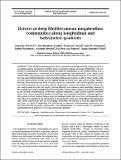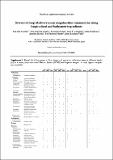Por favor, use este identificador para citar o enlazar a este item:
http://hdl.handle.net/10261/72116COMPARTIR / EXPORTAR:
 SHARE SHARE
 CORE
BASE CORE
BASE
|
|
| Visualizar otros formatos: MARC | Dublin Core | RDF | ORE | MODS | METS | DIDL | DATACITE | |

| Título: | Drivers of deep Mediterranean megabenthos communities along longitudinal and bathymetric gradients |
Autor: | Tecchio, Samuele CSIC ORCID; Ramírez-Llodra, Eva CSIC ORCID; Sardà, Francisco CSIC ORCID; Company, Joan B. CSIC ORCID ; Palomera, Isabel CSIC ORCID ; Mechó, Ariadna CSIC ORCID; Pedrosa-Pàmies, Rut; Sánchez-Vidal, Anna | Palabras clave: | Deep-sea Mediterranean Megafauna Environmental factors POC Biodiversity |
Fecha de publicación: | 20-oct-2011 | Editor: | Inter Research | Citación: | Marine Ecology Progress Series 439: 181-192 (2011) | Resumen: | The Mediterranean deep sea, being isothermal and longitudinally trophic-graded, is an optimal natural benchmark to test for macro-ecological patterns of species distribution. The relevance of environment-biota interactions on deep-sea megafauna in the Mediterranean Sea, a matter still neglected, is addressed here along longitudinal and bathymetric axes. Benthic and nektobenthic megafauna were collected in the 3 basins of the Mediterranean: the western (Catalan Sea and southern Balearic), central (western Ionian) and eastern (south of Crete) basins, with an otter-trawl Maireta system and an Agassiz dredge between 1200 and 4000 m depth. Simultaneously, environmental data were collected on surface production, near-bottom physical parameters, sediment grain size and carbon content. Megafaunal biomass was higher in the Catalan Sea, decreasing eastward and with depth. Species diversity and evenness were relatively constant in the western and central Mediterranean at all depths, whereas these indices decreased with depth in the eastern Mediterranean. β-diversity analyses indicated a high species turnover between areas. The 3 basins presented significantly different environmental conditions. Sediment particulate organic carbon, surface fluorescence and sediment grain size were the 3 environmental variables that best explained the distribution of megabenthos along the longitudinal Mediterranean axis. These results show that the food supply, from either the surface or from the adjacent deepsea floor, is critical in regulating the biodiversity of deep-sea Mediterranean megafauna and that this diversity is pooled region-wide. The heterogeneity of resources may be essential in maintaining these high levels of local and regional diversity | Descripción: | 12 pages, 5 figures, 1 table, supplementary material in https://doi.org/10.3354/meps09333 | Versión del editor: | https://doi.org/10.3354/meps09333 | URI: | http://hdl.handle.net/10261/72116 | DOI: | 10.3354/meps09333 | Identificadores: | doi: 10.3354/meps09333 issn: 0171-8630 e-issn: 1616-1599 |
| Aparece en las colecciones: | (ICM) Artículos |
Ficheros en este ítem:
| Fichero | Descripción | Tamaño | Formato | |
|---|---|---|---|---|
| Tecchio_et_al_2011.pdf | 356,38 kB | Adobe PDF |  Visualizar/Abrir | |
| Tecchio_et_al_2011_postprint.pdf | 1,08 MB | Adobe PDF |  Visualizar/Abrir | |
| Tecchio_et_al_2011_supp.pdf | 173,02 kB | Adobe PDF |  Visualizar/Abrir |
CORE Recommender
SCOPUSTM
Citations
42
checked on 10-abr-2024
WEB OF SCIENCETM
Citations
38
checked on 25-feb-2024
Page view(s)
274
checked on 18-abr-2024
Download(s)
285
checked on 18-abr-2024
Google ScholarTM
Check
Altmetric
Altmetric
NOTA: Los ítems de Digital.CSIC están protegidos por copyright, con todos los derechos reservados, a menos que se indique lo contrario.
